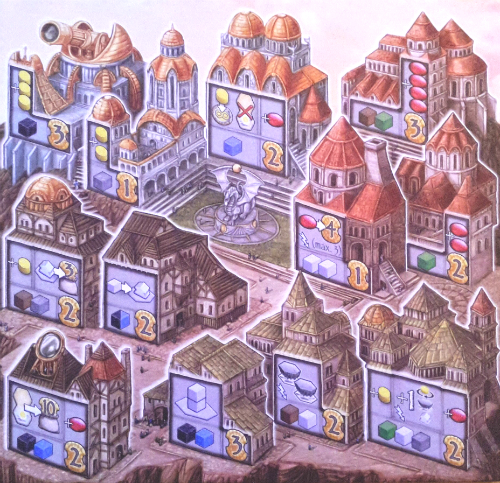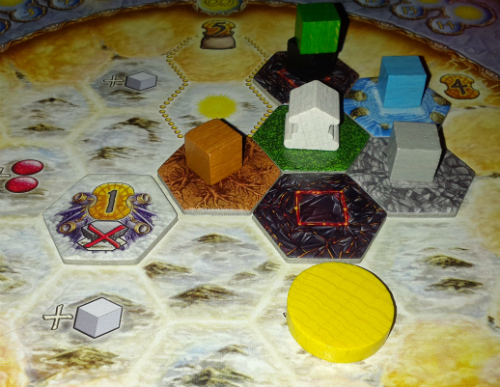Loran’s breathing was labored and uneven by the time he placed the final stone in the perimeter row. His face and hair were covered in plaster dust, an ivory coat covering the every surface but for the blotched places where his sweat had washed it away. His knees ached, which said nothing of the quiet agony in his lower back. Nevertheless, pausing to rest on the foundation he just completed, Loren caught some respite and reflected on a job well done.
“Seems like a terrible amount of effort just for a simple storage cellar, Loran. Whitewashed and plastered quarry stone? Simple wood & earthen walls can store goods just as well I say, and with far less the hassle.”
Loran was so fixated on finishing he didn’t hear his neighbor Jolar K’nei approach. “Hm? Oh, yes, yes Jolar, quite amusing. No, this is no cellar. This,” he said gesturing to his task, “is the beginnings of a new Temple to Ahau. I have donated this land and my skills to its creation in the hopes that He will look upon our people more favorably for years to come.”
Jolar, surprised, surveyed the old man’s work. “A temple? Here? Who shall attend it – the sheep?”
“Have faith Jolar. The crops grow bountifully. The town will grow in turn. People will come. Have faith.”
The Premise
The peoples of this fantasy realm aspire to take their societies to new heights, and players are at the center of this ambition. In Helios, each player put in charge of their own individual village. As ruling theocrats, players seek to grow their territory’s resources and influence, both with the other players and the mighty Sun god Ahau (may He ever light the world).
The Rules
Helios revolves around accumulating victory points through a variety of means, coming in the form of numerous resources, boards, markers, tiles, and tokens. As a result, Helios will require a moderate amount of space.
To start, three sets of tiles are centrally placed. The first are the Action tiles. Action tiles come in three different types, and the top six tiles each stack are revealed each round. The second set are eight Character tiles, which are purchased to generate VP. The final set are Earth tokens, which are broken down into six stacks the game’s five Earth resources.
Each player receives two player boards: a City board, and a Personal (village) board, as well as a bag to house VP and one Mana resource. The Personal board manages the player’s lands, resources, and the movement of their Sun, whereas the City boards track which buildings they have constructed during the game.
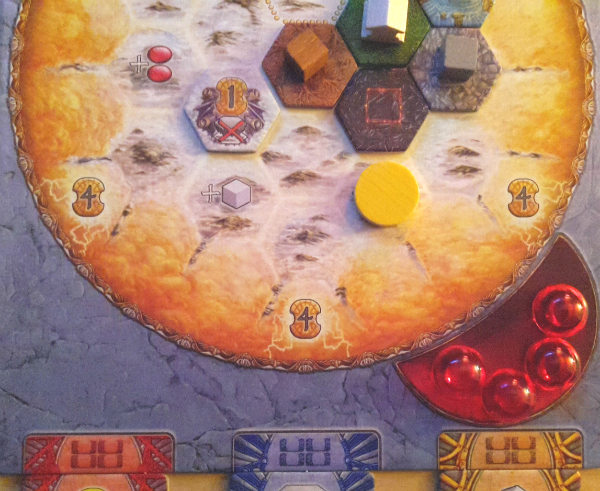
At this point in the game, the player has at least one Action tile of each color, four Mana, five Earth tokens and a Bonus token on their board.
The player who has visited the most continents begins. In turn order, each player selects one of three Earth tokens to form the center of their Personal board. Players beyond the first or second receives a bonus starting resource.
Helios consists of four rounds with two or four players, or three rounds with three, all of which are broken down into three phases. The vast majority of the game transpires during the first phase, though. During this, the Action phase, players take turns selecting one of the available Action tiles and adds it to the matching color section beneath their Personal board (with grey Action tiles being wild). Then they take its corresponding action. These are:
- Create Land: Select an available face-up Earth token, or a Bonus token from the supply, and add it to their village.
-
Building: Expend resources either to add a Temple to an Earth token space or build a building on their City board. Buildings provide unique benefits such resources, Mana, Sun movement and more. Temples have no immediate effect.
- Moving the Sun: Move the Sun clockwise around the tiles in their village, up to their maximum Sun movement. When stopped, any empty Earth tile the Sun touches generates a resource and any Temple generates VP. The Sun also generates VP by making a complete revolution around the board.
Players continue taking actions until each person has taken four, though once a player collects four Action tiles of the same color, they immediately turn them in for a free bonus action.
Helios then moves to the Characters phase. Here, players take turns purchasing and / or activating Character tiles. Unclaimed Characters can be bought by spending Mana. However, to gain the Character’s benefits players must spend additional resources to activate them.
Finally, the resources are reset by revealing a new series of Earth tokens and Action tiles, passing the first player token, and awarding bonus resources to the 3rd and 4th players.
After four rounds, the game is over. At that point, the player with the most VP has shown that they, being the most able-bodied high priest of their village, are the most worthy of Ahau’s divine attention and their people shall continue to be blessed with good fortune.
Everyone else better double down on their devotion efforts. Or start worshiping the goddess Ratri instead. Either way.
Blueprints And Bright Suns
What does the game do? What is its intent and purpose?
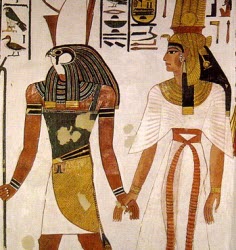
Yes, Horus, you can play too.
But not Ra. He has his own game.
These questions may sound simple because, well, they are. Or at least they should be. Many games, however, come with a less-than-clear picture of what you – and it – are supposed to be doing. For these, deciphering its actions is like staring at some exotic hand tool: you know there’s a worthwhile purpose for it, but without a point of reference you’re a bit lost. That is, the more effort you have to spend to initially understand a game, the more it tends to reduce your overall enjoyment of it.
Helios does not have this problem.
In fact, it suffers from the exact opposite malady…it’s a bit boilerplate.
On the one hand, this is a testament to how well composed and accessible Helios is. As a tried-and-true Resource Management game, all of the trademarks you’d expect are included. Decent degree of strategy? Check. Numerous ways to get VP? Check. Tight turn structures? Yep. The ability to produce lots of resources and leverage them into better opportunities? Absolutely. Helios has everything one would expect in a credible Euro, and it does it successfully. It blends those mechanics together into a system that feels familiar and yet has enough room to let players explore multiple paths to victory.
For instance, gauging how big you want your village to be versus how much you want to invest into Sun movement is just one of the decisions afforded to you in Helios.
Unsurprisingly, Helios will be highly appreciated by Tacticians for its array of strategic opportunities, and it will dissuade Daredevils due to the necessity of planning ahead and taking calculated moves over risky ones. Expect Architects to also gravitate towards the light, as you have a lot of freedom to create your village as you desire, largely free of interference.
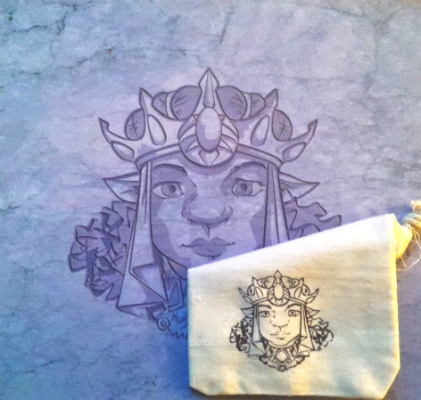
The back of the board and bag match. Unnecessary, but cool.
It also helps that Helios is both visually and physically appealing. Resources may be simple wooden cubes, but the rest of the game feels durable and sturdy, from the Temple and Mana tokens to the thick player boards. Moreover, there are a lot of little flourishes and accents that showcase the game’s overall quality and ties everything together in a stylistic way.
On the other hand, progressing through Helios can also feel like it’s all been done before. There aren’t a lot of exotic or trailblazing factors at work in this game, and while it certainly puts its own spin on the genre, it is largely safe design territory. This makes the game easier to learn than it first appears, but it also makes it difficult for Helios to separate itself from the pack of games that do pretty much the same thing. There are elements, for example, reminiscent of Puerto Rico and even Power Grid, not to mention the similar effects found in copious worker placement games such as Caylus or Le Havre.
It’s understandable then, that Strikers would shade away from this Tableau game. Aside from swiping a desired Action, Earth or Character token from another player, there isn’t much you can do to affect players the next town over. Similarly, Socializers are bound to get burnt with Helios – although the game has merit in that its rules are fairly simple and it only has an hour-ish play time, the degree of decision-making and low player interaction won’t appeal to them.
Sunny Side Up
The one notable exception that helps Helios rise above the standard resource management template is the Sun mechanic. Not only does it represent the game’s overall theme of currying the sun god’s favor, but it’s a fun method to generate resources and points. Rather than simply providing you resources at will, you must spend move the Sun to earn Ahau’s blessings. The more Actions you devote to moving the Sun, the more you can take advantage of the tiles in your village.
Sure, using the Sun to generate resources is effectively the same as other resource-generating actions (such as in Puerto Rico or Lords of Waterdeep), but Helios implements this aspect in such a flavorful and original way that it helps overshadow some of the more stock mechanics found elsewhere in the game.
That said, don’t expect Immersionists to jump for this Euro simply because it has a workable theme. The world is otherwise a stock (and nameless) fantasy realm; the only bit of creative fluff Helios includes is the name of the sun god you’re supposed to be honoring. That’s it. One word. While the world looks nice, it doesn’t invite much in the way of a worldbuilding outlet that this group thrives on, and it makes sense that they pass on it.
Character Witnesses
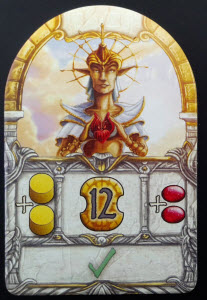
Different than a building because..um…
What makes a little less sense, though, are the eight Character tiles. From a thematic standpoint, it works: you’re spending resources to recruit specialists to your village. In turn, they help boost the VP output of your strategy significantly. However, Characters run into three notable gameplay issues that prevent the game from being as streamlined as it could be.
First, Characters serve the same purpose as Buildings. Both Buildings and Characters require time and resources to take advantage of them, both award VP at the end of the game, and a percentage of both award one-time bonuses when acquired.
The only functional differences between a Building and a Character are that Buildings help you during a game whereas Characters focus on endgame scoring, and that while anyone can build any Building, only one player can get each Character. Still, they are so similar that the game could have been better off making them Buildings with a first-come, first-serve clause instead.
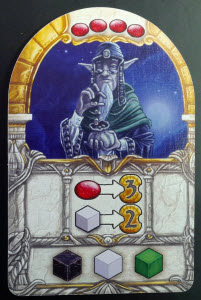
“Go Go Mana Rangers!
Da-DA-da-da-da….”
Second, purchasing Characters requires Mana. Unfortunately, Mana in Helios is like the Sixth Power Ranger of resources: it’s powerful and looks cool, but it never blends with the original five. Aside from being worth 1 VP each at the end of the game, Mana is only used to purchase Characters. This just adds complexity for complexity’s sake, providing another hoop to jump through in the quest for points.
Lastly, Characters skew the otherwise healthy diversity of strategy. They are so essential to winning that you’re required to jump through said hoops to ensure you have them.
While getting Characters reflecting your strategies drastically increases your odds of winning, there is zero advantage to forgo buying them if you can – especially with more than two players. Characters swing point totals so much that getting any are better than getting none. Maybe you’ll buy one to change your focus, or you’ll grab one block your opponent from attaining it, but get them you shall.
The Takeaway
At its fiery core, Helios is more of a slow-burning ember than a blazing tinderbox. It does what it sets out to do in a respectable manner and it certainly gets the job done, but it’s not going to spark a wildfire of excitement. Its core mechanics are solid, the Sun tracking mechanic is particularly fitting, and there are a decent amount of strategies to utilize on the path to victory. The artwork is also pleasantly integrated into the game, and the components are largely of stellar quality. Yet the game also ambles along a well-worn path by cobbling together a combination of mechanics seen many times before – it doesn’t strike a lot of new ground. There’s nothing highly negative about Helios. Rather, it just feels like it offers one attribute too many (namely Mana), or it ends one round too short. Make no mistake, Helios is a good game. It’s just not a great one.
Helios is a product of Z-Man Games.
Cardboard Republic Snapshot Scoring (Based on scale of 5):
Artwork: 4.5
Rules Clarity: 5
Replay Value: 3.5
Physical Quality: 5
Overall Score: 3.5

